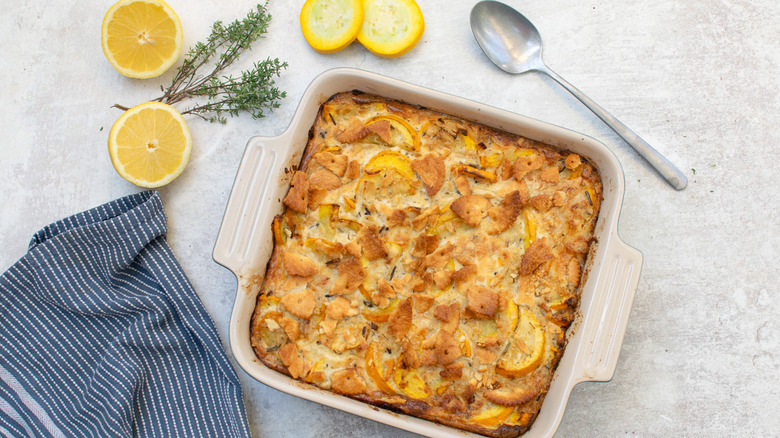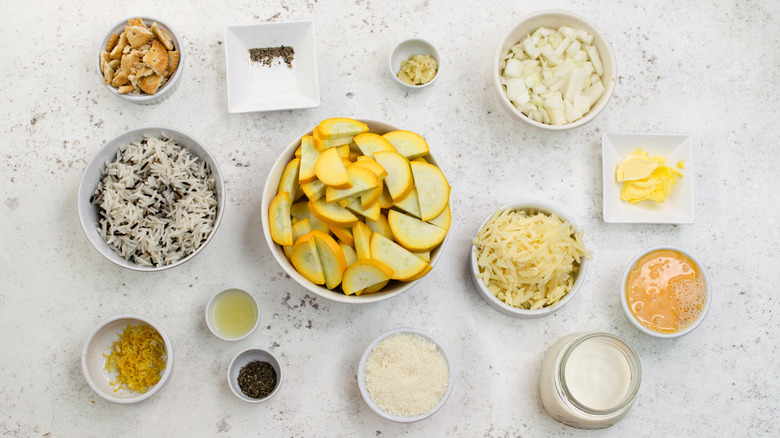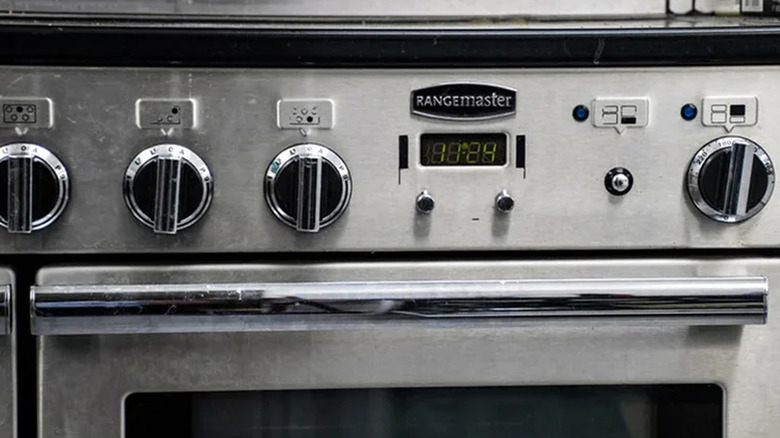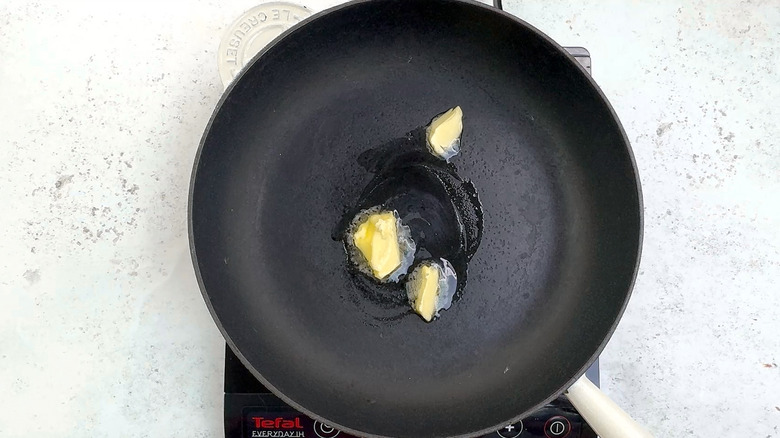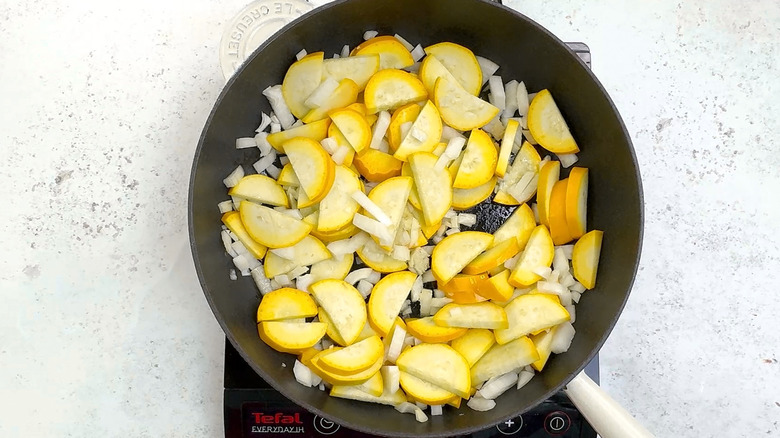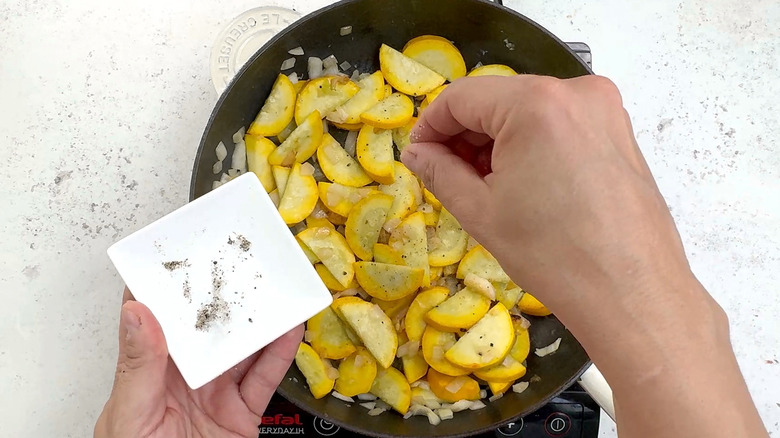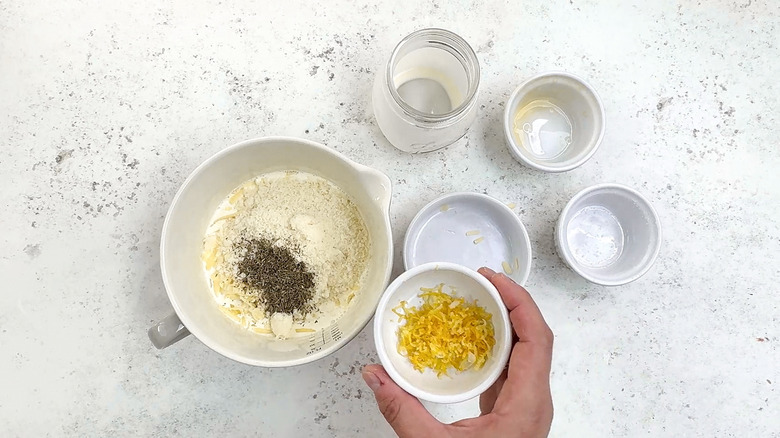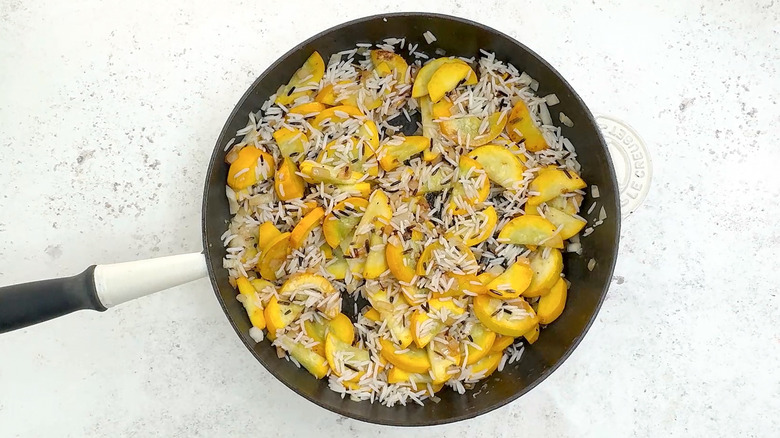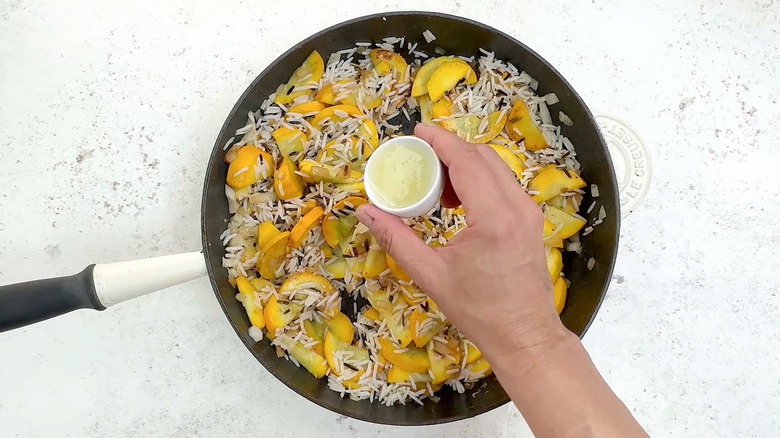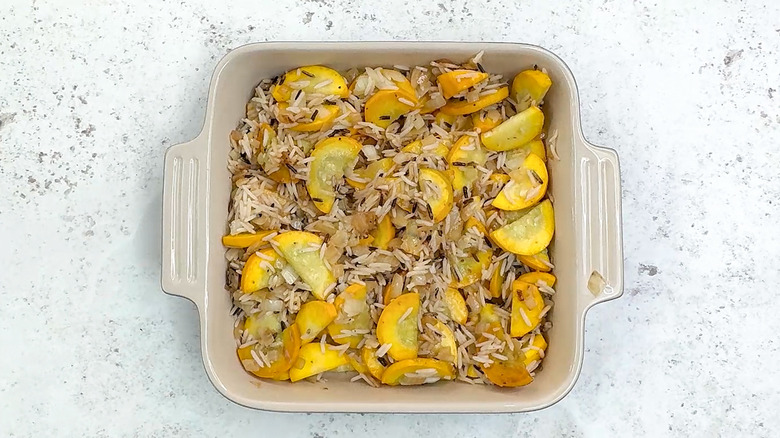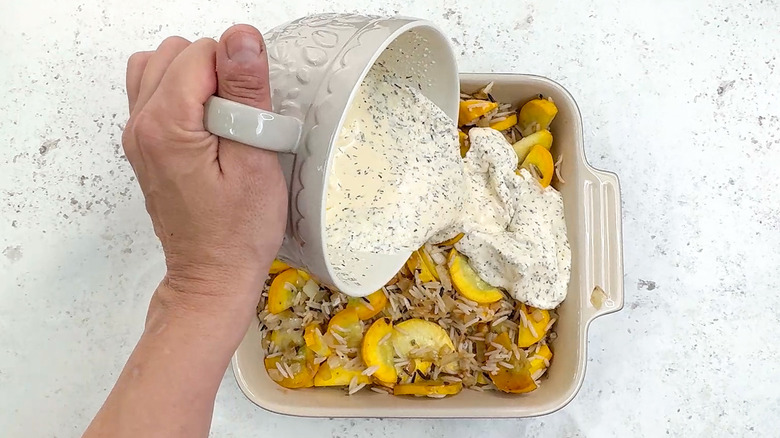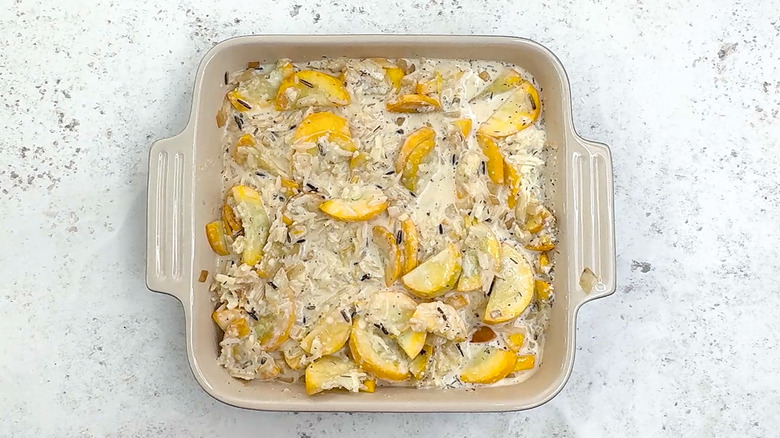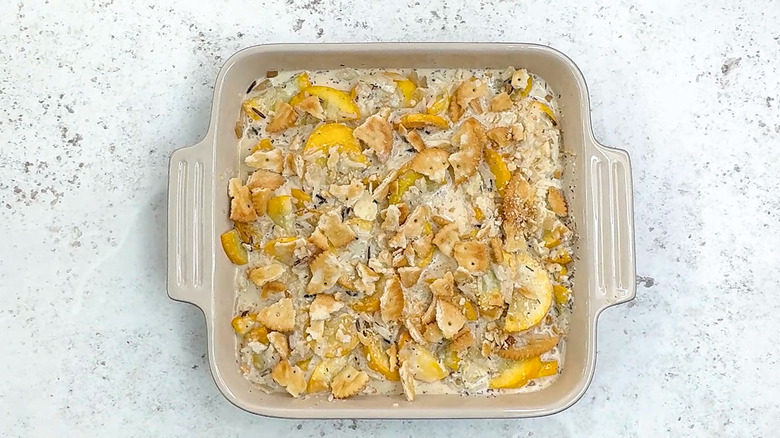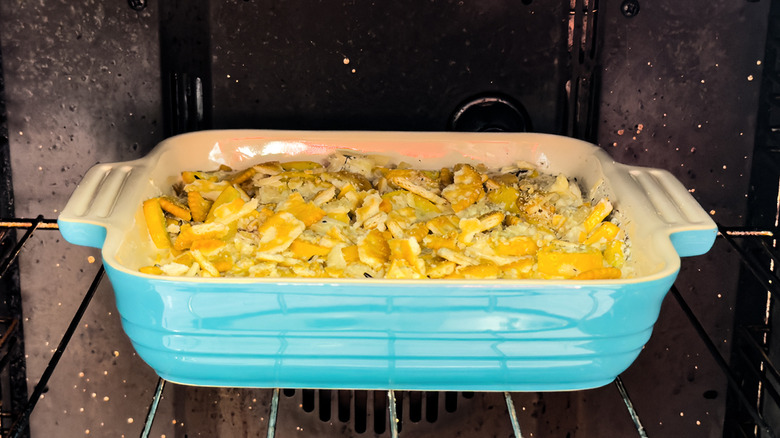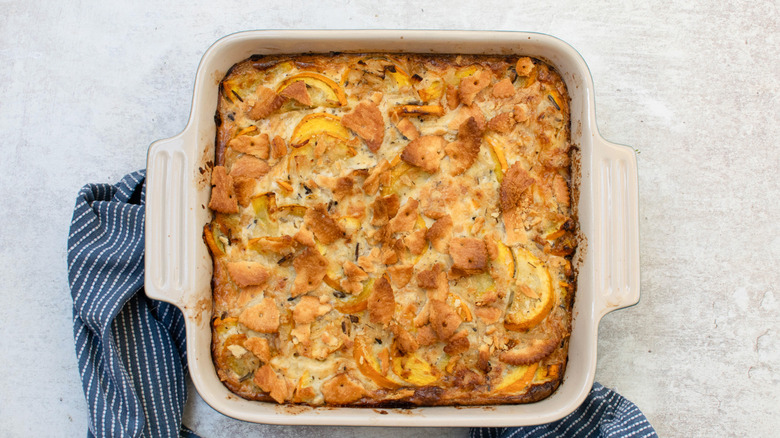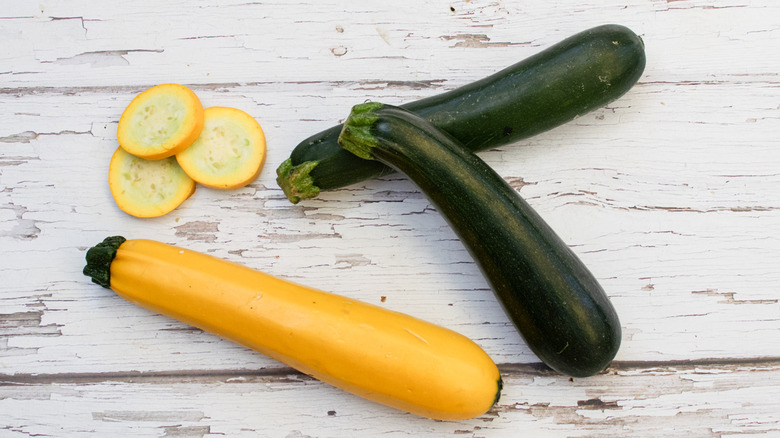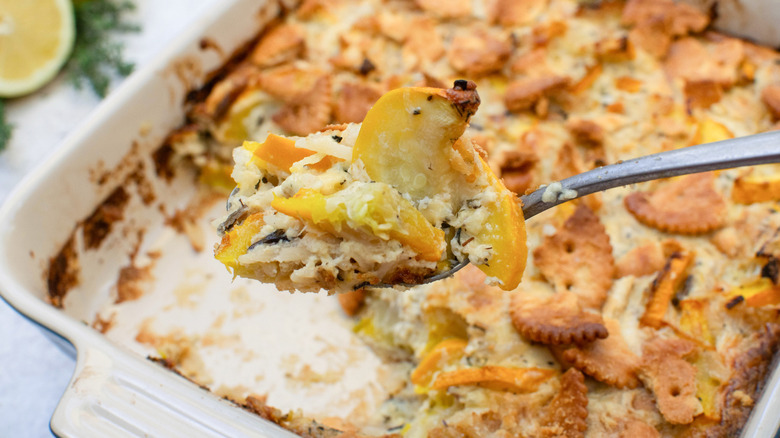Cheesy Summer Squash Casserole Recipe
Combining the fresh flavor of summer squash with a rich creamy cheese sauce, this vegetarian casserole makes a delicious and comforting meal. To provide a satisfying texture contrast, recipe developer Annabelle Randles has added some rice, which soaks up the cream sauce but retains enough integrity to keep the mixture from becoming too homogenous. Woodsy thyme adds a herbaceous note to the mild sweetness of the squash, and lemon zest and juice give the dish a welcome tart brightness. The mixture is topped with a crunchy Ritz cracker topping, which combines with the cheese to bake into a trademark gratin crispy surface. This rich combination is perfect for a hearty summer meal and is ideal to use up a glut of summer squash from your garden as well as leftover rice or other grains.
This versatile dish can be served as a vegetarian main course with a crunchy salad or as a side dish alongside grilled meat or fish. It can be prepared in advance and kept covered and refrigerated for up to a day — just wait to add the Ritz crackers till right before you bake. When you are ready to bake it, add the crackers and bake as directed. Make sure you leave the casserole to sit for 3 to 5 minutes before serving, as it will help the texture to firm up slightly.
Gather the ingredients for this cheesy summer squash casserole
To make this cheesy summer squash casserole recipe, you will need some summer squash, cooked rice, Ritz crackers, onion, garlic, heavy cream, eggs, cheddar cheese, Parmesan cheese, thyme, butter, lemon, as well as salt and pepper. You will also need an 8 x 8-inch oven dish.
Randles likes a wild rice mixture for this recipe, however other types of long-grain or medium-grain rice like jasmine, basmati, arborio, or brown rice are also suitable. Randles recommends avoiding short-grain rice which would be too sticky for this casserole.
Step 1: Preheat the oven
Preheat oven to 350 F.
Step 2: Melt the butter
Melt the butter in a large frying pan.
Step 3: Sautee the squash
Mix in the squash, onion, and garlic and cook until soft, about 8 to 10 minutes.
Step 4: Season the squash
Season to taste with salt and pepper.
Step 5: Prepare the cream filling
In the meantime, mix the cream, eggs, cheddar cheese, Parmesan cheese, thyme, and lemon zest in a mixing bowl.
Step 6: Mix in the rice
Remove the frying pan from the heat and mix the rice with the vegetables.
Step 7: Season the squash and rice
Season to taste with lemon juice, salt, and pepper.
Step 8:Add the mixture to a baking dish
Transfer the vegetable mixture to an 8 x 8-inch oven dish.
Step 9: Pour over the cream mixture
Pour the cream mixture on top of the vegetables and rice.
Step 10: Mix until combined
Using a fork, mix everything until well combined.
Step 11: Top with Ritz crackers
Sprinkle the Ritz crackers on top of the casserole.
Step 12: Bake the casserole
Bake until golden, about 35 to 40 minutes.
Step 13: Serve the casserole
Leave the casserole to sit for 3 to 5 minutes before serving.
Cheesy Summer Squash Casserole Recipe
Fresh summer squash and rice are baked in a rich creamy cheese sauce with a pinch of thyme and a hint of lemon zest in this easy summery vegetarian casserole.
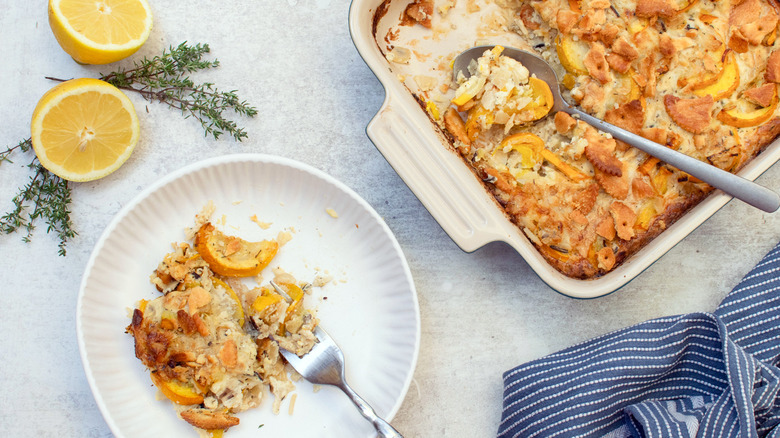
Ingredients
- 1 tablespoon butter
- 5 cups summer squash, sliced
- 1 cup finely diced onion
- 3 garlic cloves, grated
- salt and pepper
- 1 cup heavy cream
- 2 eggs, beaten
- 1 cup cheddar cheese, grated
- ⅓ cup Parmesan cheese, grated
- 1 teaspoon dry thyme
- Zest and juice of ½ lemon
- 1 ½ cups cooked rice
- ½ cup roughly crumbled Ritz crackers
Directions
- Preheat oven to 350 F.
- Melt the butter in a large frying pan.
- Mix in the squash, onion, and garlic and cook until soft, about 8 to 10 minutes.
- Season to taste with salt and pepper.
- In the meantime, mix the cream, eggs, cheddar cheese, Parmesan cheese, thyme, and lemon zest in a mixing bowl.
- Remove the frying pan from the heat and mix the rice with the vegetables.
- Season to taste with lemon juice, salt, and pepper.
- Transfer the vegetable mixture to an 8 x 8-inch oven dish.
- Pour the cream mixture on top of the vegetables and rice.
- Using a fork, mix everything until well combined.
- Sprinkle the Ritz crackers on top of the casserole.
- Bake until golden, about 35 to 40 minutes.
- Leave the casserole to sit for 3 to 5 minutes before serving.
Nutrition
| Calories per Serving | 403 |
| Total Fat | 28.6 g |
| Saturated Fat | 16.5 g |
| Trans Fat | 0.6 g |
| Cholesterol | 130.6 mg |
| Total Carbohydrates | 24.1 g |
| Dietary Fiber | 2.2 g |
| Total Sugars | 5.2 g |
| Sodium | 608.6 mg |
| Protein | 14.1 g |
Can I use other vegetables and grains in this casserole?
This casserole recipe can be adapted to use different seasonal vegetables. In the summer, you can use any type or mixture of tender summer squash such as green or gray zucchini, yellow squash, marrow, crookneck, and so on. For a tasty Mediterranean version inspired by ratatouille, you can also combine zucchini, eggplant, and bell pepper. Fall and winter vegetables like winter squash, pumpkin, sweet potato, cauliflower, broccoli, leek, potato, and Brussels sprouts would also work really well. Make sure you blanch these heartier vegetables first as it will help to soften them and speed up the cooking process.
To add texture, Randles likes to add some wild rice mix to this casserole. This can be adapted to use any leftover cooked grains you might have like cooked quinoa, barley, farro, or bulgur wheat. While whole grains work really well with softer vegetables, they also add texture and flavor to fall and winter vegetable casseroles.
What is the difference between a casserole and a gratin?
Both casseroles and gratins offer a mixture of ingredients in 1 dish — in each case, the dish they're cooked and served in also shares their name. While casseroles and gratins have a lot of similarities, key differences do set them apart. One of the most famous gratins, gratin Dauphinois (aka Potatoes au gratin) is the best example of a gratin's defining attributes. A gratin is typically made with thinly sliced vegetables combined with cream and aromatics. A gratin dish is shallow and round or oval with a lot of surface area, which means that a gratin tends to be thin and crispy. The vegetables are layered, then covered in a rich creamy sauce, sometimes with cheese added, often topped with more cheese or breadcrumbs, and then cooked until the inside is tender and the top is crispy and brown.
By contrast, a casserole is more homogeneous in texture and cooked in a deeper oven dish. Casseroles have come to be equated with thrifty recipes designed to stretch a protein source into a complete meal, and often include a mixture of ingredients such as meat, tuna or seafood, vegetables, and whole grains, all combined with a creamy cheese sauce. Rather than being layered, the ingredients and sauce are mixed together and then baked, resulting in a hearty and comforting dish.
